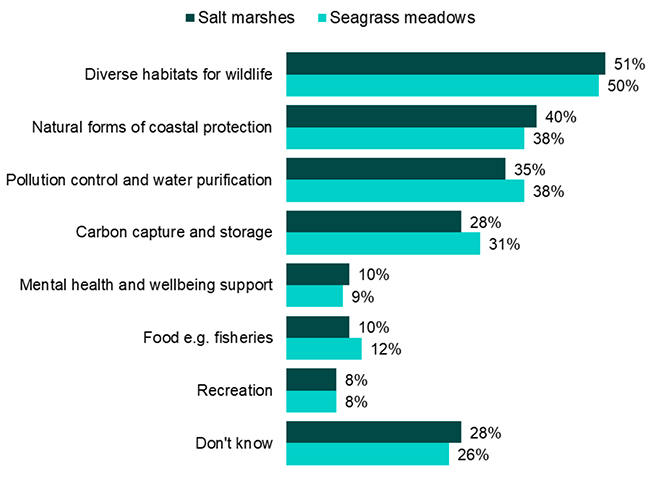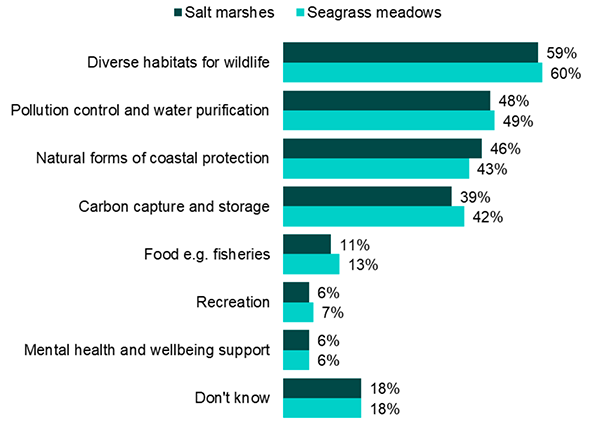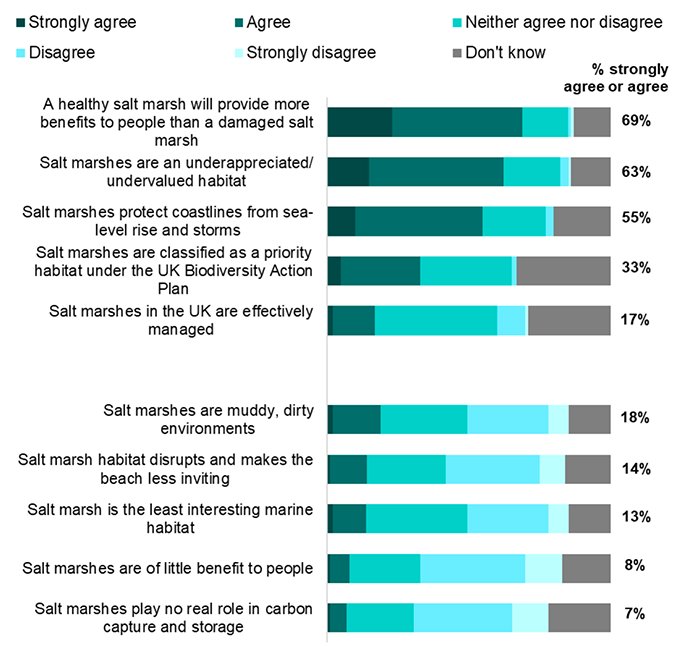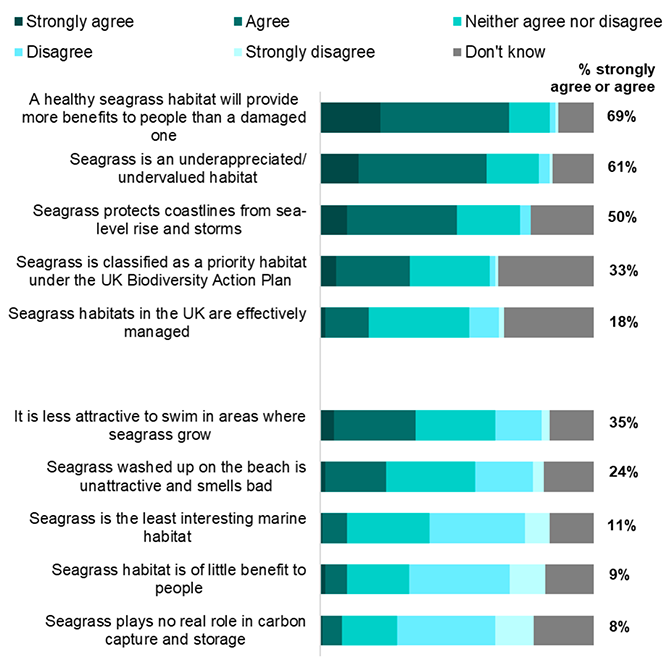Ocean literacy survey: headline findings
Headline findings from an online survey with the public in Scotland on the topic of ocean literacy - exploring the public's understanding of the marine environment. It is part of a wider project covering England and Wales.
Salt marshes and seagrass meadows
Potential benefits of salt marshes and seagrass meadows
For both salt marshes and seagrass meadows the most important benefits that came through were diverse habitats for wildlife (51% for salt marshes and 50% for seagrass meadows), natural forms of coastal protection (40% for salt marshes and 38% for seagrass meadows) and pollution control and water purification (35% for salt marshes and 38% for seagrass meadows).
The least important benefit identified by respondents for salt marshes and seagrass meadows was recreation (both 8%).
In both instances, over a quarter indicated that they did not know what the benefits from these ecosystems were (Figure 7).

NQ5: The following are a range of potential benefits of salt marshes and sea grass meadows. In your opinion for each habitat, which three do you think are the most important?
Unweighted base: 3,055
Dimensions
- Personal or emotional connection
- Attitudes
- Knowledge
- Awareness
Restoring salt marshes and seagrass meadows
Fourteen percent of respondents said they were aware of efforts to restore salt marshes, and 11% said they were aware of efforts to restore seagrass meadows.
Respondents were then presented with a range of reasons for restoring salt marshes and seagrass meadows and were asked which three were most important (Figure 8).
Again, the pattern of response was very similar for both salt marshes and seagrass meadows, with diverse habitats for wildlife regarded as the most important (59% for salt marshes and 60% for seagrass meadows), followed by pollution control and water purification (48% for salt marshes and 49% for seagrass meadows), natural forms of coastal protection (46% for salt marshes and 43% for seagrass meadows) and carbon capture and storage (39% for salt marshes and 42% for seagrass meadows).

NQ10: The following are a range of reasons for restoring salt marshes and seagrass meadows. In your opinion for each habitat, which three do you think are the most important reasons to restore these habitats?
Unweighted base: 3,055
Dimensions
- Attitudes
- Knowledge
- Awareness
Views on salt marshes
Respondents were asked to rate their level of agreement with a range of statements relating to salt marshes (Figure 9).
Agreement was strongest that a healthy salt marsh will provide more benefits to people than a damaged salt marsh (69%), followed by agreement that salt marshes are an underappreciated habitat (63%) and that salt marshes protect coastlines from sea-level rise and storms (55%).
There were relatively high levels of 'don't know' responses across the board, but particularly in relation to salt marshes being classified as a priority habitat under the UK Biodiversity Action Plan (33%) and salt marshes in the UK being effectively managed (29%).

NQ11: The following are statements about salt marshes. For each habitat, please indicate to what extent you agree with each statement.
Unweighted base: 3,055
| Statement | Strongly agree | Agree | Neither agree nor disagree | Disagree | Strongly disagree | Don't know | Summary: Strongly Agree or Agree |
|---|---|---|---|---|---|---|---|
| A healthy salt marsh will provide more benefits to people than a damaged salt marsh | 23% | 46% | 16% | 1% | 1% | 13% | 69% |
| Salt marshes are an underappreciated/ undervalued habitat | 15% | 48% | 20% | 3% | 1% | 14% | 63% |
| Salt marshes protect coastlines from sea-level rise and storms | 10% | 45% | 22% | 3% | <0.5% | 20% | 55% |
| Salt marshes are classified as a priority habitat under the UK Biodiversity Action Plan | 5% | 28% | 32% | 2% | <0.5% | 33% | 33% |
| Salt marshes in the UK are effectively managed | 2% | 15% | 43% | 10% | 1% | 29% | 17% |
| Salt marshes are muddy, dirty environments | 2% | 17% | 31% | 29% | 7% | 15% | 18% |
| Salt marsh habitat disrupts and makes the beach less inviting | 1% | 13% | 28% | 33% | 9% | 16% | 14% |
| Salt marsh is the least interesting marine habitat | 2% | 12% | 36% | 29% | 7% | 15% | 13% |
| Salt marshes are of little benefit to people | 1% | 7% | 25% | 37% | 13% | 17% | 8% |
| Salt marshes play no real role in carbon capture and storage | 1% | 6% | 24% | 35% | 13% | 22% | 7% |
Dimensions
- Attitudes
- Knowledge
- Awareness
Views on seagrass meadows
Respondents were asked to rate their level of agreement with a range of statements relating to seagrass meadows (Figure 10).
As with salt marshes, agreement was strongest that a healthy seagrass habitat will provide more benefits to people than a damaged one (69%), followed by agreement that seagrass are an underappreciated habitat (61%) and that seagrass meadows protect coastlines from sea-level rise and storms (50%).
Again, there were relatively high levels of 'don't know' responses across the board, but particularly in relation to seagrass meadows being classified as a priority habitat under the UK Biodiversity Action Plan (35%) and seagrass in the UK being effectively managed (33%).

NQ12: The following are statements about seagrass meadows. For each habitat, please indicate to what extent you agree with each statement.
Unweighted base: 3,055
| Statement | Strongly agree | Agree | Neither agree nor disagree | Disagree | Strongly disagree | Don't know | Summary: Strongly Agree or Agree |
|---|---|---|---|---|---|---|---|
| A healthy seagrass habitat will provide more benefits to people than a damaged seagrass habitat | 22% | 47% | 15% | 2% | 1% | 13% | 69% |
| Seagrass is an underappreciated/ undervalued habitat | 14% | 47% | 19% | 4% | 1% | 15% | 61% |
| Seagrass protects coastlines from sea-level rise and storms | 10% | 40% | 23% | 4% | <0.5% | 23% | 50% |
| Seagrass is classified as a priority habitat under the UK Biodiversity Action Plan | 6% | 27% | 29% | 2% | 1% | 35% | 33% |
| Seagrass habitats in the UK are effectively managed | 2% | 16% | 37% | 11% | 2% | 33% | 18% |
| It is less attractive to swim in areas where seagrass grow | 5% | 30% | 29% | 17% | 3% | 16% | 35% |
| Seagrass washed up on the beach is unattractive and smells bad | 2% | 22% | 32% | 21% | 4% | 18% | 24% |
| Seagrass is the least interesting marine habitat | 1% | 9% | 30% | 35% | 9% | 16% | 11% |
| Seagrass habitat is of little benefit to people | 2% | 8% | 23% | 37% | 13% | 18% | 9% |
| Seagrass plays no real role in carbon capture and storage | 1% | 7% | 20% | 36% | 14% | 22% | 8% |
Dimensions
- Attitudes
- Knowledge
- Awareness
Contact
Email: socialresearch@gov.scot
There is a problem
Thanks for your feedback